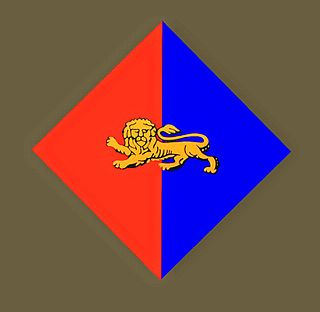215th Brigade was a Home Service formation of the British Army during the First and the Second World Wars.

The 301st Infantry Brigade was a formation of the British Army organised from surplus Royal Artillery (RA) personnel retrained as infantry towards the end of the Second World War.
The 303rd Infantry Brigade was a formation of the British Army organised from surplus Royal Artillery (RA) personnel retrained as infantry towards the end of the Second World War.

The 304th Infantry Brigade was a formation of the British Army organised from surplus Royal Artillery (RA) personnel retrained as infantry towards the end of the Second World War.
306th Infantry Brigade was a British Army formation organised towards the end of the Second World War from surplus Royal Artillery (RA) personnel who had been retrained as infantry.
307th Infantry Brigade was a formation of the British Army organised from surplus Royal Artillery (RA) personnel retrained as infantry towards the end of the Second World War.
308th Infantry Brigade was a formation of the British Army organised from surplus Royal Artillery (RA) personnel retrained as infantry towards the end of the Second World War.
The 205th Independent Infantry Brigade (Home) was a short-lived Home Defence infantry brigade formation of the British Army during the Second World War.
27th Anti-Aircraft Brigade was an Air Defence formation of the British Army in World War II that served in The Blitz and later converted to infantry.
26th (London) Anti-Aircraft Brigade was an Air Defence formation of the British Army during World War II. It defended London during the Blitz.

The 36th (Middlesex) Searchlight Regiment was a volunteer air defence battalion of Britain's Territorial Army (TA) from 1936 until 1961, at first as part of the Royal Engineers, later in the Royal Artillery. As part of 40th Anti-Aircraft Brigade it defended air bases in East Anglia through the Battle of Britain and the Blitz. Towards the end of 1944 the unit underwent infantry training, serving briefly in Norway at the end of the war. After the war, the 36th continued as a TA unit, with some women serving with it. In 1961, the remnants of the regiment amalgamated with others to form a combined infantry battalion, and all links with air defence were severed.
The 28th (Essex) Searchlight Regiment was a volunteer air defence unit of Britain's Territorial Army (TA) from 1935 until 1961, at first as part of the Royal Engineers, later in the Royal Artillery. During the Second World War it defended the approaches to London in The Blitz and Operation Diver before becoming a garrison unit in the liberation of Norway.
The 38th Light Anti-Aircraft Brigade was an air defence formation of Britain's Territorial Army formed just before World War II, which protected London and Southern England during the Blitz and later converted into an infantry formation for the liberation of Europe.
The 30th (Northumbrian) Anti-Aircraft Brigade was an air defence formation of Britain's Territorial Army from 1936 until 1955, which defended Tyneside and Sunderland during World War II.
58th (Middlesex) Searchlight Regiment, Royal Artillery was an air defence unit of Britain's Territorial Army (TA) raised just before World War II. It defended the East Midlands of England during The Blitz, and later served as infantry in North West Europe at the end of the war, converting to the anti-aircraft (AA) artillery role postwar.

48th (Hampshire) Searchlight Regiment, Royal Artillery was an air defence unit of Britain's Territorial Army (TA) formed just before the outbreak of World War II from existing searchlight companies of the Royal Engineers. It served in Anti-Aircraft Command until 1944, including the Portsmouth Blitz and Operation Diver. At the end of the war it formed an infantry unit for garrison duties in liberated Europe. It continued in the postwar TA until AA Command was disbanded in 1955.
The 6th Battalion, Essex Regiment was a volunteer unit of Britain's Territorial Army. First formed in the docks of East London in 1860, it served as infantry at Gallipoli and in Palestine during the First World War. It later formed searchlight units of the Royal Artillery (RA), serving during the Blitz.

The 51st (Highland) Searchlight Regiment, Royal Artillery was a Scottish unit of Britain's Territorial Army (TA) formed for air defence just before World War II. It later served as an anti-aircraft (AA) artillery unit in the North West Europe Campaign 1944–45, and continued in the postwar TA into the 1950s.

The 56th Anti-Tank Regiment was a Territorial Army unit of the British Army's Royal Artillery (RA), which converted from the 4th Battalion, King's Own Royal Regiment (Lancaster). During the Second World War, it first served with the 42nd Division in the Battle of France and Dunkirk evacuation in May–June 1940. In 1942, it was sent to join the 70th Infantry Division in India, where it was converted into a Light Anti-Aircraft/Anti-Tank Regiment. In this guise, it served in the Burma Campaign, mainly with the 5th Indian Infantry Division. It reconverted to the anti-tank role in late 1944 and in June 1945 it returned to India as a training unit. It continued serving in the TA postwar until 1961, when it re-merged into the King's Own.

73rd Heavy Anti-Aircraft Regiment, Royal Artillery was a West Midlands-based volunteer air defence unit of Britain's Territorial Army (TA) raised in 1937. During World War II, it served in the Battle of France, The Blitz, Egypt, Sicily and Italy. Postwar, its successor regiments continued to serve until 1967, and a battery descended from the regiment forms part of today's Army Reserve




